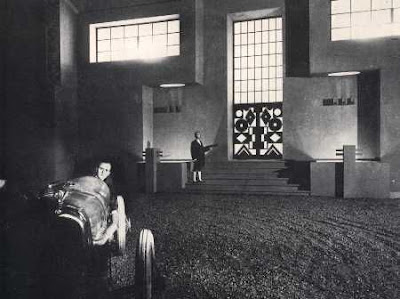It's impossible for any pair of eyes to view all of Frisco Bay's worthwhile film screenings. I'm so pleased that a number of local filmgoers have let me post their repertory/revival screening highlights of 2011. An index of participants is found here.
The following list comes from Margarita Landazuri, who writes for and co-edits the SF Silent Film Festival program book. Undoubtedly two silent films by Marcel L'Herbier-- L'Argent (1928), at the San Francisco Silent Film Festival's winter event, and L'Inhumaine (1924) at PFA a few weeks later, were the standouts for me. The latter, which someone described as a "Surrealist Bride of Frankenstein," is a loony combination of sci-fi and avant-garde high style. It boasts gorgeous, fanciful sets and costumes, bad acting and a silly story, but it's loads of fun.The production credits read like a laundry list of 1920s Modernist art: sets and decor by Fernand Léger, Alberto Cavalcanti, Claude Autant-Lara and Rene Lalique, costumes by Paul Poiret.
Undoubtedly two silent films by Marcel L'Herbier-- L'Argent (1928), at the San Francisco Silent Film Festival's winter event, and L'Inhumaine (1924) at PFA a few weeks later, were the standouts for me. The latter, which someone described as a "Surrealist Bride of Frankenstein," is a loony combination of sci-fi and avant-garde high style. It boasts gorgeous, fanciful sets and costumes, bad acting and a silly story, but it's loads of fun.The production credits read like a laundry list of 1920s Modernist art: sets and decor by Fernand Léger, Alberto Cavalcanti, Claude Autant-Lara and Rene Lalique, costumes by Paul Poiret.
Even though it's based on a 19th-century Emile Zola novel and was made in the 1920s, L'Argent feels totally 21st century in its themes of stock market manipulation, corporate greed, and celebrity mania. It also feels thoroughly modern with its on-location shooting, huge, complex sets and crowd scenes, surrealist touches, and dazzling camerawork and editing. The Mont Alto Motion Picture Orchestra's score was superb.
 My other two favorites from last summer's SFSFF last summer were Mauritz Stiller's The Blizzard (Gunnar Hedes Saga, 1923) and The Woman Men Yearn For (1929). In The Blizzard, based on a novel by Nobel laureate Selma Lagerlof, Stiller translates Lagerlof's literary themes of nature and mysticism into visual storytelling. In the romantic melodrama The Woman Men Yearn For, Marlene Dietrich explodes the myth that she was a creation of director Josef von Sternberg in The Blue Angel. Made a year before she met von Sternberg, The Woman Men Yearn For presents Dietrich as the fully-formed femme fatale that later became famous. She is introduced in the film looking out from a frosted train window, gazing impassively at the hapless young man who will become her victim. I don't think I imagined it: the audience gasped. There she was, the Marlene we all know, a sleeker and more more sophisticated version of Blue Angel's Lola Lola, ready to use and abuse another besotted male.
My other two favorites from last summer's SFSFF last summer were Mauritz Stiller's The Blizzard (Gunnar Hedes Saga, 1923) and The Woman Men Yearn For (1929). In The Blizzard, based on a novel by Nobel laureate Selma Lagerlof, Stiller translates Lagerlof's literary themes of nature and mysticism into visual storytelling. In the romantic melodrama The Woman Men Yearn For, Marlene Dietrich explodes the myth that she was a creation of director Josef von Sternberg in The Blue Angel. Made a year before she met von Sternberg, The Woman Men Yearn For presents Dietrich as the fully-formed femme fatale that later became famous. She is introduced in the film looking out from a frosted train window, gazing impassively at the hapless young man who will become her victim. I don't think I imagined it: the audience gasped. There she was, the Marlene we all know, a sleeker and more more sophisticated version of Blue Angel's Lola Lola, ready to use and abuse another besotted male.
Wednesday, January 18, 2012
Margarita Landazuri Only Has Two Eyes
Subscribe to:
Post Comments (Atom)





Thanks
ReplyDelete